Top 10 Procurement Statistics You Need to Know


Health and geopolitical crises, supply chain disruptions, high price volatility, demand uncertainty, and quickly shifting consumer preferences have made the procurement landscape and global market increasingly complex.
In this context, procurement departments have a unique role to play in navigating these complexities and achieving cost savings, supply chain resilience, and sustainable supplier relationships.
The awareness of these factors is reflected in the ten latest procurement statistics we outlined in this article, each unveiling crucial insights into the state of procurement today.
This statistic implies that a significant majority of companies are recognizing the value of data analytics and reporting in improving their procurement performance.
That’s not surprising since data analytics and reporting tools can help companies manage the dynamic procurement landscape, potentially resulting in lower costs, better supplier compliance, and improved negotiation positions.
This statistic comes from The Hackett Group’s study “The CPO Agenda – 2024 Procurement Key Issues” which surveyed company executives about the key procurement issues and improvement initiatives they’re planning.
As highlighted in red below, investments in data analytics and reporting tools top the list of chief procurement officers (CPOs) planned improvement initiatives.

Illustration: Veridion / Data: The Hackett Group
Moreover, the surveyed executives evaluated which of these initiatives are critical (high priority with low maturity), and data analytics again came on top, followed by sustainable procurement, supplier relationship management, and third-party risk management.
These findings illustrate the key role data analytics and reporting have in today’s procurement, such as their ability to provide insights into spending patterns, supplier performance, and market trends.
In summary, this statistic indicates that CPOs recognize that, when properly leveraged, AI-driven data analytics tools can help them streamline time-consuming and complex procurement tasks to improve processes and achieve cost reductions.
Similar to the statistic we just covered, the fact that 55% of companies plan to increase their supply chain investments in 2024 shows the extent of current challenges in the procurement landscape and opportunities provided by new technologies.
This statistic was extracted from a survey done as part of the 2024 Annual Industry Report “The Collaborative Supply Chain – Tech-Driven and Human-Centric” published by MHI and Deloitte, which covered more than 1,700 procurement leaders worldwide.
The survey findings revealed that 55% of them plan to increase investments in emerging supply chain management technologies, with 88% saying they’ll spend more than $1 million and 42% over $10 million.
The report predicts that these investments will lead to a dramatic increase in the adoption of such technologies in the next five years.
Here are the main technological advancements in supply chain management and their expected growth in that period:
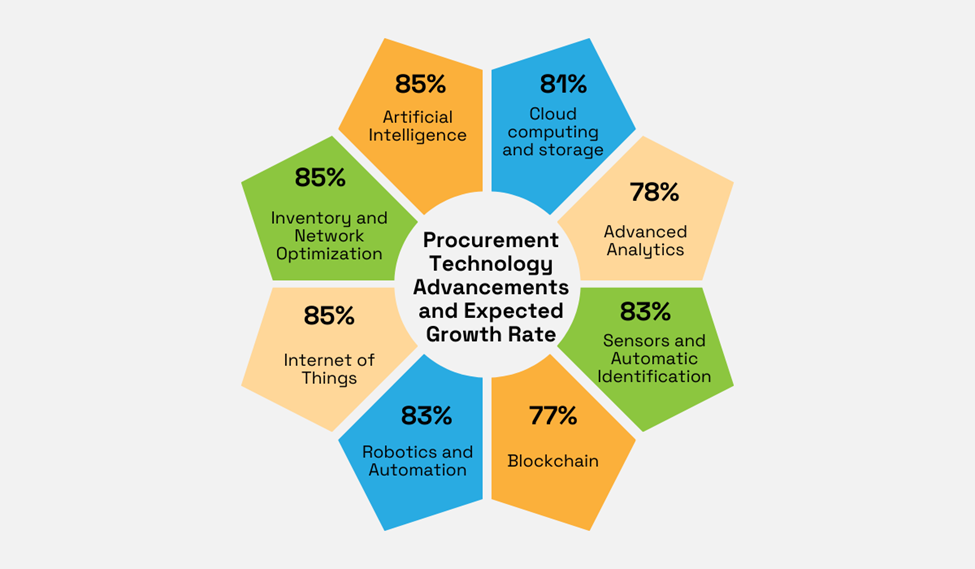
Illustration: Veridion / Data: MHI
As illustrated, supply chain investments encompass solutions aimed at enhancing supply chain resiliency and transparency, and addressing workforce shortages.
This surge in investments also signals a strategic move by businesses toward long-term success rather than merely reacting to short-term challenges.
Overall, by investing in procurement technologies, companies want to harness their capabilities and make their supply chains more agile and resilient, enabling them to navigate market fluctuations, proactively manage disruptions, and capitalize on emerging opportunities.
This statistic highlights the difficulties businesses are encountering in their efforts to achieve procurement sustainability goals.
With the growing emphasis on ESG (environmental, social, and governance), i.e., sustainable practices, it’s not surprising that companies face challenges in assessing the sustainability credentials of potential suppliers.
The extent of such difficulties (85%) was fully revealed in Amazon Business’s annual study “2024 State of Procurement Report – The Trends Shaping the Future of Business Buying”, which surveyed 3,108 procurement decision-makers.
The problems in finding suppliers with sustainable practices and checking their credentials are often related to inaccurate, incomplete, or outdated supplier data.
This issue can be efficiently addressed by utilizing external, regularly updated supplier databases with search functions that enable you to quickly find and easily evaluate potential suppliers against a range of sustainability/ESG criteria.
One such tool is our supplier sourcing solution, Veridion.
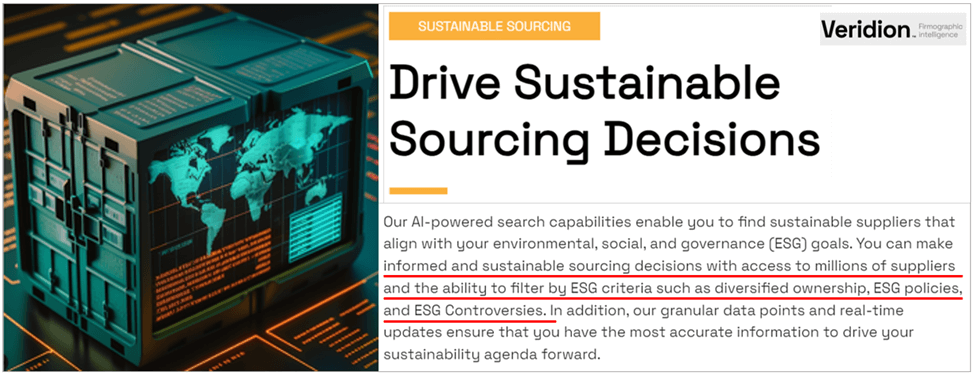
Source: Veridion
As illustrated, the ability to access a global database with millions of suppliers and filter them by any criteria, including ESG, empowers companies to align their procurement practices with sustainability goals.
Therefore, by leveraging innovative, AI-driven solutions and robust supplier evaluation mechanisms, companies can overcome the challenges in ensuring adherence to ESG principles throughout their supply chain.
This growth projection for the procurement software market underscores the increasing importance of digitalization and online connectivity in procurement operations.
One of the primary drivers of procurement software market growth is that businesses recognize the need for streamlined and efficient procurement processes to remain competitive in today’s dynamic market.
As a result of this widespread recognition, when Verified Market Research made its projections, they concluded that the procurement software market, valued at $5.5 billion in 2020, will grow about 7.6% per year and reach the value of $9.5 billion in 2028.

Illustration: Veridion / Data: Verified Market Research
This growth is fueled by various procurement software solutions, spanning from e-procurement systems and supplier relationship management software to data analytics tools and big data platforms.
Despite their varied purposes and features, these solutions share a common attribute: automation capabilities that streamline processes, minimize errors, and expedite the procurement cycle.
Furthermore, they empower companies to make better-informed, data-driven decisions, enhancing overall efficiency and competitiveness.
As the market continues to expand, companies can anticipate further advancements in software functionalities, coupled with potential price decreases.
This statistic tells us that over half of risk professionals find that risk management technologies enable them to make better-informed procurement decisions.
In the PWC’s 2023 US Risk Perspectives Survey, 57% of surveyed procurement professionals reported significant improvements in risk management based on insights from different technologies, such as automated workflows, advanced analytics, and machine learning/AI.
As shown below, another return on investing in risk management technologies is the better identification of new supply chain risks reported by 48% of respondents.
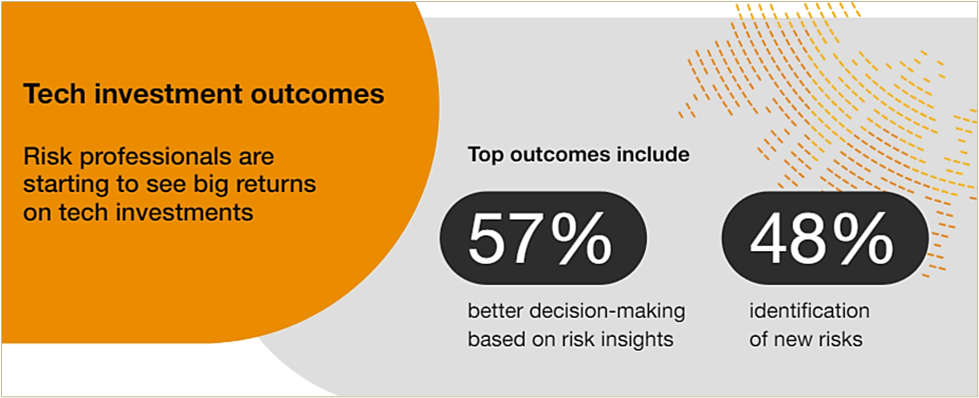
Source: PWC
Although these percentages are noteworthy, there is still a lot of room for improvement, especially with regard to driving not only quality-increasing but also efficiency-boosting outcomes.
Again, this may be achieved by utilizing the right risk management tools and providing appropriate training to improve both data quality and personnel analytics skills.

Source: Veridion
For instance, tools like Veridion enable risk professionals to automate supplier risk monitoring, i.e., set custom risk factors and receive real-time alerts when changes in a supplier’s business activities trigger them.
Overall, while companies are already extracting significant insights from risk management and mitigation technologies that enable better decision-making, these benefits will only increase over time through proper tech adoption and staff training.
This is another finding from Amazon Business’s “2024 State of Procurement Report”, which shows the overwhelming preparedness of decision-makers to invest in technologies that streamline their procurement operations.
These technologies include:
As illustrated below, these investment plans are driven by businesses recognizing procurement efficiency and complexity as the biggest challenge and detecting room for procurement optimization, leading to higher procurement budgets in 2024.

Source: Amazon Business
The survey also revealed that the same number of respondents (98%) who are planning investments would like to learn more about new digital tools that can improve their procurement performance.
In summary, this statistic shows that, in 2024 and beyond, companies will be focused on providing procurement teams with the tools, skills, and strategies required to boost their efficiency and agility.
This survey-based statistic underscores the significant concern among supply chain leaders regarding the impact of inflation on their companies and procurement operations.
According to a survey conducted for MHI and Deloitte’s 2024 Annual Industry Report, 53% of respondents identified rising prices due to inflation as extremely or very challenging for their procurement operations.
This level of concern is unsurprising, given the multitude of past and present global procurement challenges such as pandemics, wars, natural disasters, and climate-related supply chain disruptions.
Of course, each country also possesses unique factors that contribute to its own inflation, as demonstrated by the IMF’s 2024 inflation rate projections depicted in the world map, where darker colors indicate higher rates.
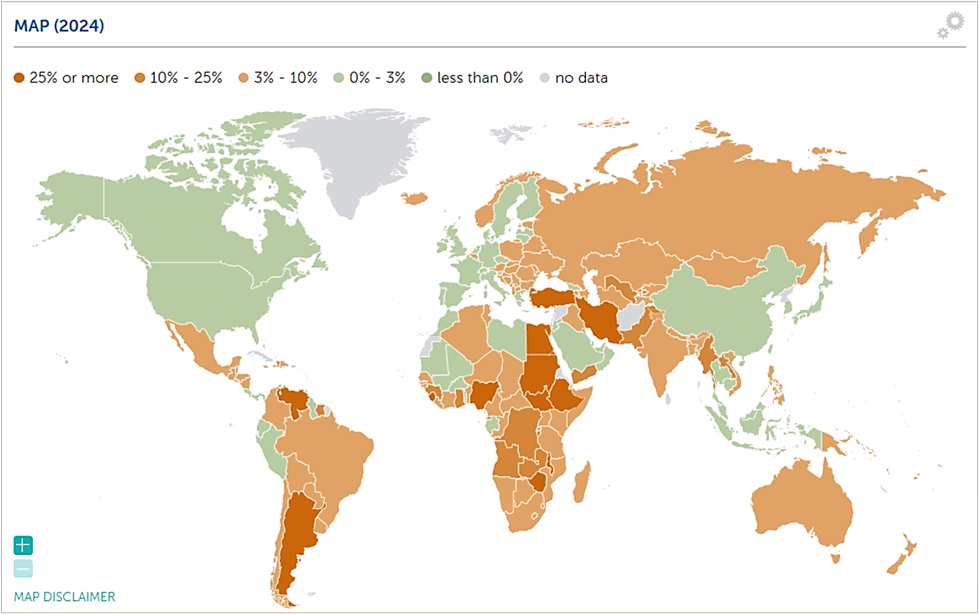
Source: IMF
In a globally interconnected procurement landscape, inflation-driven price increases in one country can reverberate across borders, exacerbating the negative effects of inflation on businesses worldwide.
In essence, inflation simultaneously increases prices of raw materials, labor, and other operational requirements and reduces customer demand.
This can lead to reduced profits, particularly when companies can’t increase the prices of their products and services correspondingly due to competitive pressures or market constraints.
To mitigate the impact of inflation, companies can leverage technological tools and data-driven procurement strategies to analyze market trends, identify cost-saving opportunities, and optimize procurement strategies in response to changing economic conditions.
This statistic comes from BCG, a consulting firm.
They surveyed over 600 company executives in different regions and industries and presented their findings in “The CEO’s Guide to Costs and Growth – Strategic Priorities and Opportunities in 2024”.
Mirroring their 2023 findings, BCG’s survey showed that cost management remains a top priority for executives in 2024.
This is because—despite their somewhat more optimistic outlook for 2024—corporate leaders are still cautious due to many reasons, such as inflation, geopolitical conflicts, rising interest rates, and upcoming elections in key markets like the U.S. and India.
Consequently, executives are prioritizing initiatives aimed at optimizing supply chain and manufacturing costs to bolster financial resilience.

Source: BCG
Among other things, this means that company executives should be open to implementing efficiency-raising and cost-saving initiatives proposed by the procurement team.
Additionally, the survey indicated that, while companies are generally successful in cutting costs, many struggle to maintain the achieved cost-savings (35%) or report negative impacts on growth (27%).
Overcoming these challenges requires a holistic approach to supply chain and manufacturing cost management, supported by robust data analysis tools.
The survey of 111 procurement leaders by Gartner Inc. in June 2023 showed that only a small number of companies are sure about having the procurement talent with the right technology and data analysis skills and expertise.
This survey also showed relatively high leaders’ confidence in their current procurement talent, with 46% of respondents indicating they have adequate talent to meet near-term procurement performance requirements.
Conversely, only 14% of leaders are confident about the future talent availability.
In the words of Fareen Mehrzai, Senior Director Analyst in Gartner’s Supply Chain Practice:
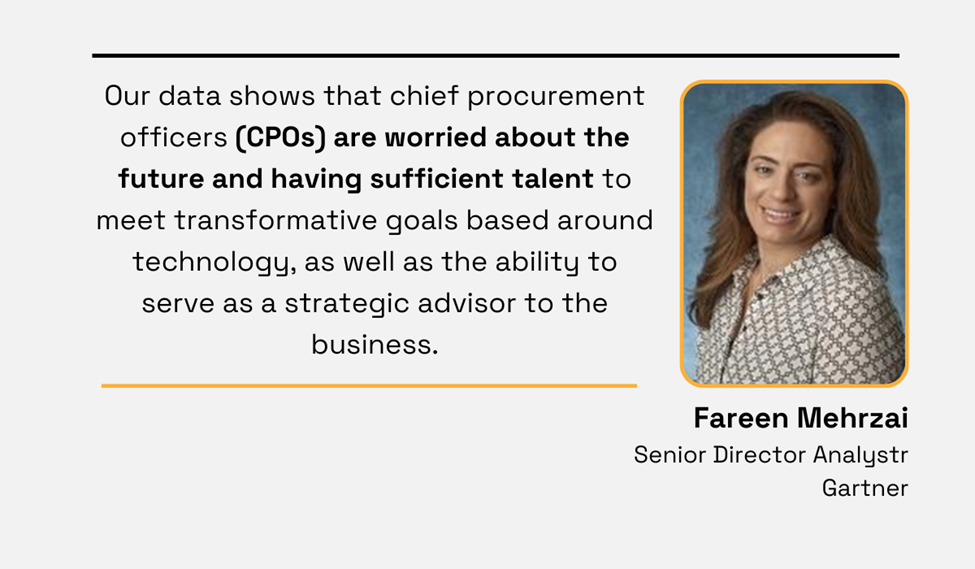
Illustration: Veridion / Data: Gartner
This disparity between current and future talent availability perceived by procurement leaders underscores the pressing need for organizations to proactively address skill gaps and invest in talent development initiatives.
As the procurement landscape continues to evolve with advancements in technology and data analytics, companies must prioritize upskilling their workforce to ensure readiness for future challenges and opportunities.
Lastly, The Hackett Group’s 2024 Key Issues Study predicts an 8% increase in the procurement workload for the year, accompanied by expected productivity and efficiency gaps.
In other words, while the responsibilities of procurement teams keep growing in both number and complexity, this is not followed by a corresponding increase in their staffing levels and budgets.
As illustrated, it is projected that the said increase in the workload of procurement functions in 2024 will create a 6.6% productivity gap and a 6.4% efficiency gap.

Source: The Hackett Group
Furthermore, the study predicts a 4.6% increase in procurement technology spend, which is a result of companies trying to close these gaps by leveraging procurement automation and data analytics solutions.
In addition to technology investments, companies can address these issues by optimizing existing processes, providing adequate training, enhancing cross-departmental collaboration, and acquiring new talent.
So, what do the statistics presented here tell us?
First, they show that the procurement landscape is evolving rapidly, driven by technological advancements, global challenges, and shifting market dynamics.
Second, they highlight the critical importance for companies to adapt and innovate in their procurement strategies.
Ultimately, this means that companies should leverage procurement data analytics and automation tools, talent development, and strategic investments to navigate procurement complexities, optimize operations, and drive sustainable growth.